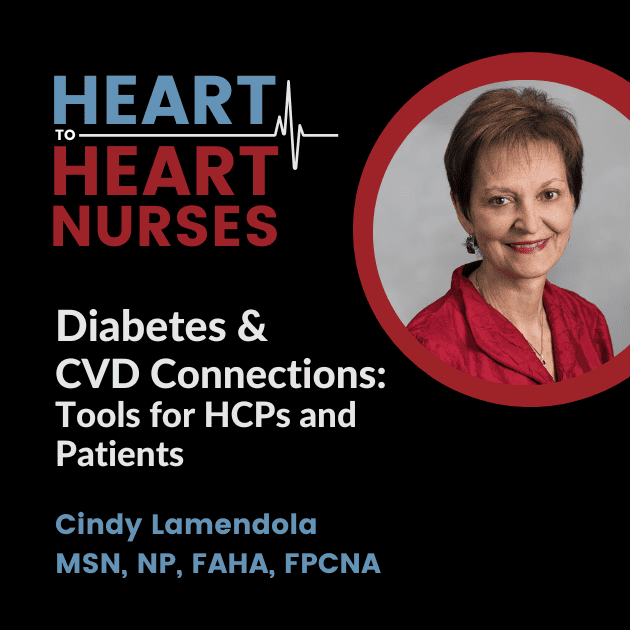Guest Cindy Lamendola, MSN, NP, FAHA, FPCNA, describes the connections between CVD and diabetes, and related tools for both health care professionals and patients. Cindy also discusses clinical trials and the role each HCP plays in ensuring representation by diverse populations.
Episode Resources
- Global Heart Hub
- Know Diabetes by Heart
- Interactive patient education: Diabetes and Your Heart: Close Connections
- Tool for Healthcare Providers: Guidelines for Managing Cardiovascular Disease Risk in Patients with Diabetes
Welcome to Heart to Heart Nurses, brought to you by the Preventive Cardiovascular Nurses Association. PCNA’s mission is to promote nurses as leaders in cardiovascular disease prevention and management.
Geralyn Warfield (host): I’d like to welcome our audience today, and I’d also like to welcome our guest, Cindy Lamendola. Cindy, could you introduce yourself to our audience please?
Cindy Lamendola (guest): Hi everyone. This is Cindy Lamendola. I’m a nurse practitioner and at Stanford University and Stanford Healthcare. I have a 25% position in clinical practice with cardiovascular patients with lipid disorders and other heart disease disorders.
And I have a 75% position in research, which I’ve done for 25 years—wooo!—or maybe longer, actually. And I’m very proud to say I’m a [00:01:00] founding board member of PCNA, which I’m very, very proud of. And we’re having a wonderful year and we have a lot to talk about.
Geralyn Warfield (host): We definitely do, Cindy. Thanks so very much for joining us today and thank you also from the bottom of our hearts for being one of the key founders of PCNA and starting our organization off on its trajectory. And we’re so excited to have you here today.
I know that you have multitude of passions when it comes to cardiovascular care, but one of the key things that we have talked about most recently includes the link between diabetes and cardiovascular disease. And I’m hoping you could talk just a little bit about how we can help both providers and patients make that connection a little bit more strongly so that we can set our patients up for better success.
Cindy Lamendola (guest): Yes. Thank you for that introduction to that very important topic. In doing a little bit of preparation for today, I was reading a review article that is in Diabetes Care, about that it, [00:02:00] it really wasn’t until the 1960s and 70s that we even started to see the relationship between cardiovascular disease and diabetes.
And I know for many people that’s like a long time ago, but for some of us it feels like “Really?! You’d think we would’ve known about that so many years before that.” And now we think it’s very obvious. “Oh, of course, people with diabetes understand that they have a high risk for cardiovascular disease.” Or, “Of course, providers are telling their patients, you know, not only do we need to get your diabetes under control, but we need to get all your cardiovascular risk factors, because this is your highest risk.”
Patients with diabetes are more scared or more concerned about kidney disease, to be honest with you; about glucose not being well controlled and that they might lose one of their limbs. That really is, if you ask them what they’re most concerned about, those are the two things. They don’t really see that [00:03:00] heart disease, or we should say cardiovascular disease, is really the number one issue for them.
And so, there are a lot of campaigns out there trying to link this with the, the provider and the patient, because interestingly also, it’s not that providers aren’t aware, but sometimes in their clinics they’re very, very busy. And so, then the focus—or just the message to patients—is, well, we’re getting your blood sugars under control and we’re getting your blood pressure and your cholesterol, but it’s because of you’re at high risk for heart disease or, you know, disease of the arteries in your, your legs or neck. So that, that’s a big focus for us.
I have been involved in several organizations as well as PCNA, and I’ll go over later what we have done. So, one of the groups that I was involved with, as a liaison from PCNA [00:04:00], was called the Global Heart Hub.
And we developed a cardiovascular diabetes think tank and a call to action. And bas basically it was advancing action through patient collaboration. It was an all-day meeting. It was all done through ZOOM, and we were coming up with ideas (and these were people from all over the world) as to how to improve the knowledge of patients, getting knowledge out to patients and, and patients’ knowledge about the relationship between cardiovascular disease and diabetes.
So that was, that was very important. There has been a, a paper released and then we’re going to be working on the next call to action. But there’s, these were nurses, physicians, patient advocates. So, they [00:05:00] kind of covered the whole realm of the, I guess, of diabetes.
There was also a, a group called Know Diabetes by Heart through American Heart Association, which has, I was on that committee for several years and I think, as we’re doing today, we had podcasts, we have webcasts, and they did just a small survey and it was very interesting.
They looked at endocrinologists, cardiologists, nurse practitioners, physician assistants, and to see who was basically kind of aware of this relationship, which is, well, come on, everybody knows, and it was interesting because a lot of peoples said they didn’t really focus on that with their patients. They really focused just on whatever care they were giving that patient, whether it was cardiovascular or whether it was endocrinology. [00:06:00]
So, I found that also very interesting and I think it’s also a good topic for our organization, PCNA, to step up and do more for in terms of educating both professional groups and our patients.
So, I’m very proud of something that we did and, Geralyn, you were a big part of that. So, something called Diabetes and Your Heart: Close Connections. And it is a piece for patients, and it’s actually—well, it wasn’t paper. I’m not sure if it’s still available on paper, but it’s also online.
It’s a wonderful piece talking about taking care of yourself basically from the patient’s perspective. Giving them tips on how to make changes and how to make behavioral health changes. And what I love about it is they can have it online. They can, you know, have someone read it. They can, you know, check a [00:07:00] little word and it’ll tell you what it means. And so, it’s, it’s very, very patient-oriented. I really love that piece.
And then there’s another little card that we put out, Diabetes and Cardiovascular Disease, for healthcare providers, which, because there are so many medications that go together. So, if you’re seeing a patient with diabetes, you need to really know the diabetes medications they’re on, and you also need to know the medications they need to be on for cardiovascular disease. And, lo and behold, now there are several medications that cover both, which is great.
And so, we did a wonderful job providing all that information on a little pocket card, but it also can find that online. And so, we’re in the, in the midst of updating that. But, so, great information.
I still think it’s a topic that is going to [00:08:00] be ongoing for many years. A lot of these medications are expensive, a lot of difficulty in getting people to get them, and a lot of probably, maybe, inertia from both healthcare providers and patients to change medications to get on these new medications. Being concerned about side effects.
But, I think we’re moving in the right direction. There just is a lot more we can do. A lot more.
And I think there’s also attention being taken in terms of even commercials. If you see commercials about the relationship between cardiovascular disease and diabetes, I think, you know, we need to get to social media, you know, television, radio, whatever, where we can also have that information to patients and providers, because people pay attention to that.
Geralyn Warfield (host): We’ve been talking with Cindy [00:09:00] Lamendola and we will be right back.
Geralyn Warfield (host): We’re back with Cindy Lamendola and we know that one of her passions is the link between diabetes and cardiovascular disease. But another area of expertise that she alluded to in her introduction is her work with clinical research.
And I’m hoping, Cindy, you could enlighten our audience a little bit about what it takes to actually get patients enrolled in clinical trials, some of the challenges you face each and every day, and maybe how all of us can be a little bit more cognizant of getting more diverse patient populations enrolled in these studies.
Cindy Lamendola (guest): That’s a good topic, Geralyn, and, and one good thing I will tell you, at least I think in academia, there now is a bigger focus on making sure we have a diverse population in our research trials. And I think that’s very, very important.
It can be a real struggle. When you start a study, obviously there are several, you have a lot of different avenues to go, for [00:10:00] trying to recruit, we call them study participants, but the patients into your study.
And so, many years ago it was using ads in the newspaper. So, we thought if we put them in the right types of newspaper, we can get more people to come in. In the types of studies that I did many years ago, some of the, some of the, testing that we did on our, our patients for the study meant that they had to come in for a whole day. So that meant a whole day of missing work for some people. And there might have been two and a half days in the whole study,from the beginning and the end.
So, I knew that that was going to be a really a big barrier for some people. And, and I think it was, if we look at our data.
I think right now, it has gotten, it’s improved a lot.
So, there are organizations that are being developed that are doing it [identifying potential study participants] for [00:11:00] the, the study people. So, they’re, they’re going out to using all the social media to try to get patients. And we’re doing other things like providing, providing either money for them [the patients], for travel time. Also for providing rides, which can be very, very important for people that don’t have transportation.
And we can use our systems within the hospitals also to, you know, you put in certain criteria and then you can get, you know, how many patients that might have that problem. And then when you go through your IRB [institutional review board], you will get permission to actually look at those, that patient population so that you can either call the physician first or call the patient to see if they’re interested.
So, we have a lot more avenues. It’s still really difficult. If you have a certain patient population, people with type two diabetes or people with cardiovascular disease, then you also work with your colleagues. So, we send out messages to our colleagues, constantly reminding them; [00:12:00] when we have meetings, we present what we’re going to, what our study’s going to be about, so they’ll be looking for those patients.
But it’s really the study coordinators and managers that are, are doing that. And the PIs [primary investigators] are really focused. You know, we meet once a once a week, at least, to make sure how are you getting your patients? Are you calling people? Are they calling you back? and I think we still have a long ways to go to meet the diversity criteria.
People want to be in these studies. They want to take advantage. They want that information for themselves and for their, their own social group. So, again, we go to TV commercials and I’ve seen more commercials now where different ethnicities are talking about, well, “I want to be in those studies too.”
And that also helps the patients to then go and ask their [00:13:00] providers, “Are there any new studies out that I can participate?” So, I think all of those things, hopefully in the next, maybe as quick as five years, 10 years, I think we’ll see a big change because we need more information like that. Right?
If you even think about the, the cardiovascular pool cohort, you know, risk reduction, risk evaluation—we don’t have enough information to really evaluate everyone’s risk for cardiovascular disease accurately. So, this, this is an ongoing thing, but I think with research this will, we will meet those goals.
Geralyn Warfield (host): Cindy, is there anything else that you’d like to talk about that I’ve neglected to ask?
Cindy Lamendola (guest): I would like to say in my career, it has been very exciting to, to be able to be, be a part of this marriage of knowledge between when you’re caring for patients with diabetes and cardiovascular disease, or [00:14:00] cardiovascular disease with high risk for getting diabetes. That’s the population maybe we didn’t talk about.
So, there’s a lot of people in our practices that have a lot of risk factors for Type 2 Diabetes. And, because Type 2 Diabetes is 90 to 95% of the, the population with diabetes.
And we know it’s a growing concern. We know it’s a growing concern, not only for adults, but it’s growing in teenagers. And it’s very, very—actually “scary” might be the word—that we as providers and practitioners need to take account of that.
So again, it’s been exciting to be part of that. To talk to people so that they’re aware of their risks. To not only just look at your blood sugar, but also to let people know, yes, this is [00:15:00] important, but it’s just as important to let your, to talk about your cholesterol, to talk about your blood pressure, to see how your kidneys are doing. And we have to remember that.
For every patient that we see…I mean, just as we call ourselves as a, as a group that’s preventing, I mean, we’re always preventing—whether it’s primary, secondary, tertiary, or whatever. But, every patient that we see probably has a high risk for, you know, not every, but many patients have high risk for getting Type 2 Diabetes as well as cardiovascular disease.
So, we want to prevent both. So, I’d say that that would be a great goal for all of us.
Geralyn Warfield (host): Well, thank you so very much for that call to action for us to be thinking holistically about our patients and their ongoing risk for developing Type 2 Diabetes, for developing cardiovascular disease.
It has been a delight spending time with you, Cindy. Thank you so very much. This is Geralyn Warfield, your host, and we will see you next time. [00:16:00]
Thank you for listening to Heart to Heart Nurses. We invite you to visit pcna.net for clinical resources, continuing education, and much more.
Topics
- Diabetes
Published on
May 30, 2023
Listen on:
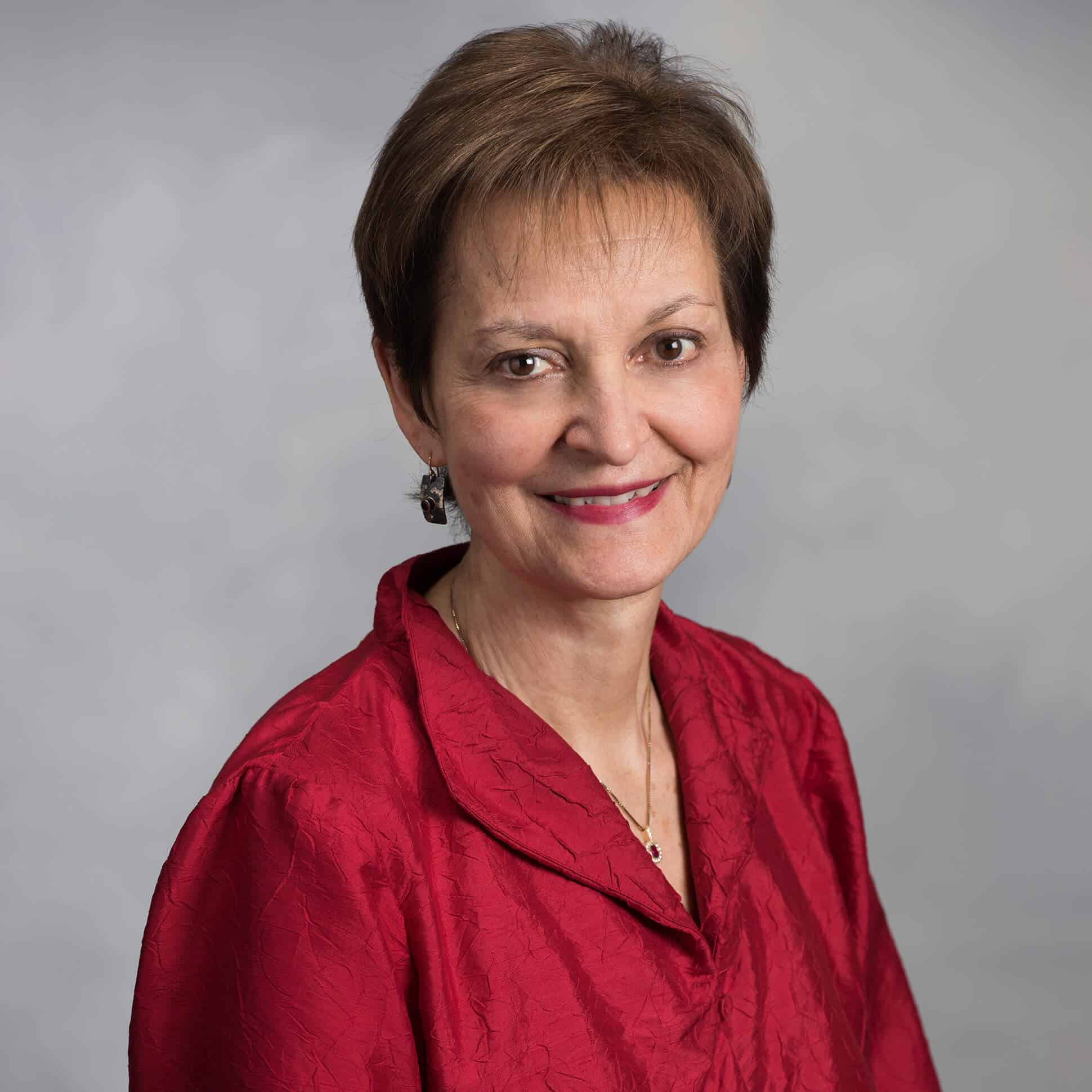
MSN, NP, FAHA, FPCNA
Related Resources
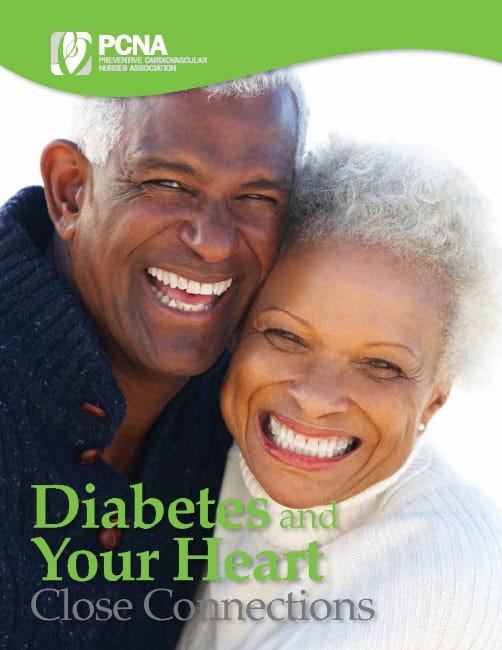
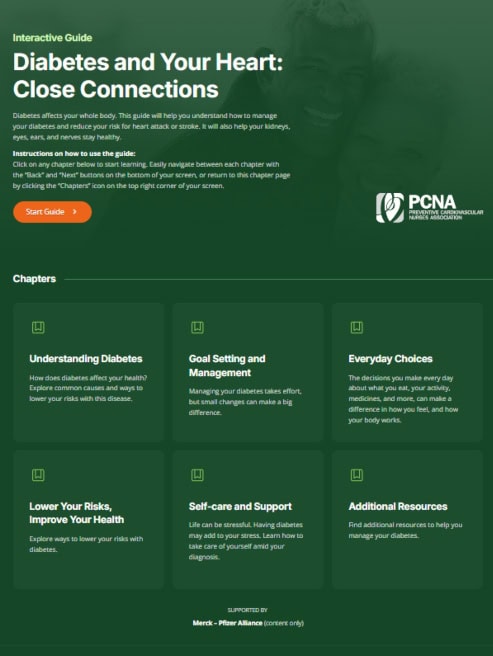
Online Interactive Guides
Diabetes and Your Heart: Close Connections Online Interactive Patient Tool
June 12, 2025
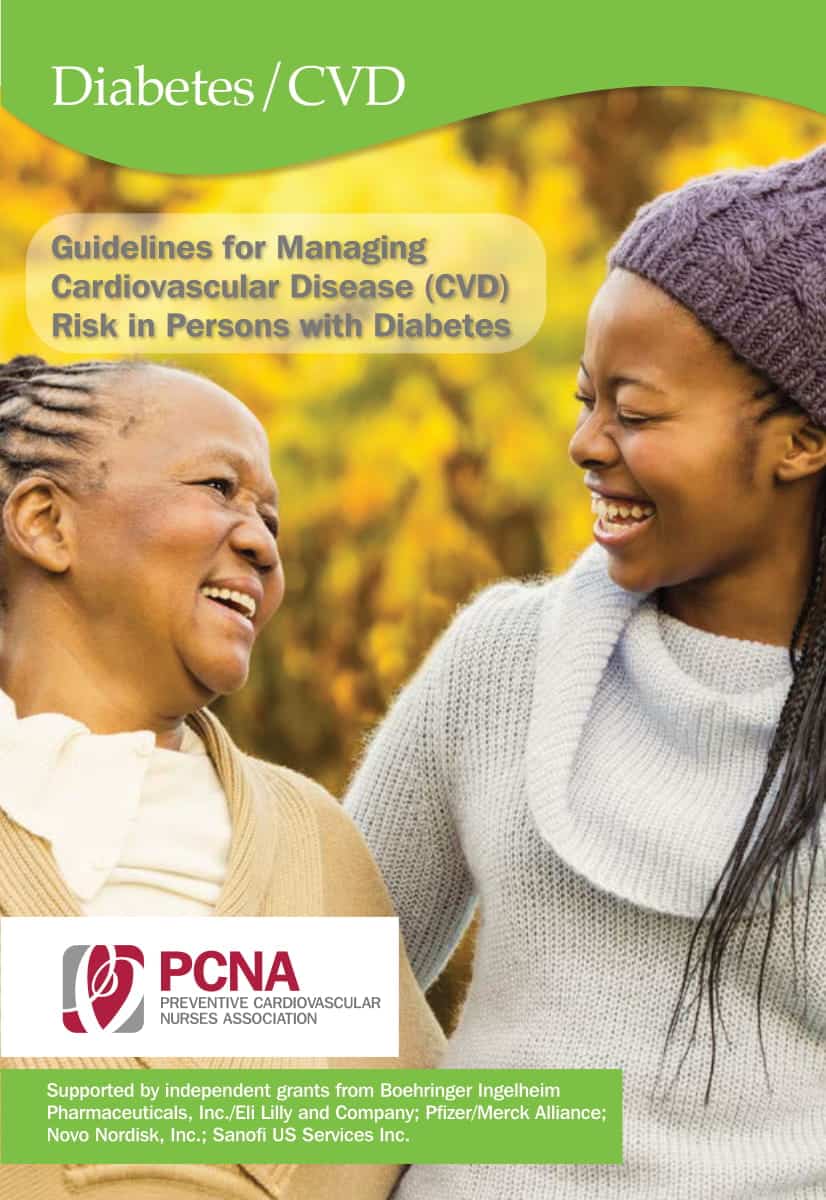
Provider Tools
Guidelines for Managing Cardiovascular Disease Risk in Patients with Diabetes Pocket Guide
January 19, 2025






